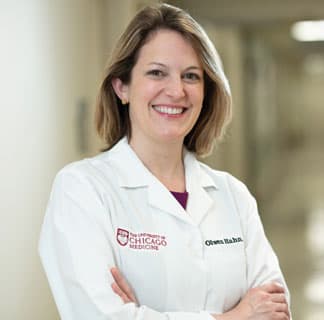Imaging and deep learning in precision medicine for cancer
Computer-aided detection (CADe), for example, uses quantitative image analysis methods to recognize patterns of breast cancer on mammograms that radiologists may miss. CADe is an artificial intelligence technology for cancer detection, initially for breast and lung images, which was developed and translated for ultimate clinical use by a team of medical physicists and radiologists at the University of Chicago in the 1980s.
Today, more than 80 percent of screening mammograms are read by a computer as a “second reader.” In addition, multiple algorithms are being translated for the detection and follow-up of lung nodules on thoracic radiographs and computed tomography (CT) scans.
Beyond detecting cancer, computers have proven useful in diagnosis. Computer-assisted diagnosis (CADx) aims to help physicians diagnose cancer accurately by analyzing the features of an image and estimating the likelihood that those features correspond to a specific disease state, such as a tumor being cancerous or not.
Over the past few decades, advances in new computer technologies and image acquisition and analysis tools have enabled deeper learning from medical images than ever before possible. Imaging data are, therefore, increasingly valuable for many applications in cancer, including risk assessment, detection, diagnosis, prognosis, therapy response, and basic scientific research.
Unleashing Imaging's Potential with Radiomics and Deep Learning
Even with these tremendous advances, there is still great untapped potential to use information from medical images to support physician decisionmaking. In recent years, CAD has expanded to a broader field called radiomics, which involves the conversion of images into minable data. Obtaining radiomic data may involve computer segmentation of a tumor from its background followed by computer extraction of various tumor features, including size, shape, texture, and margins (morphology), as well as other features related to physiologic processes.
Maryellen Giger, PhD, A.N. Pritzker Professor of Radiology and Vice-Chair for Basic Science Research in the Department of Radiology, and a nationally recognized leader in the field of quantitative imaging, is at the forefront of radiomics.
Identifying image-based features that characterize cancer is a primary goal of radiomics. Further, Giger and others are merging these image-based features through machine learning algorithms to yield tumor signatures.
Mining Imaging Data for Discovery
Machine learning is dependent on large datasets of tumor images across diverse populations. The Cancer Imaging Archive (TCIA) is a National Cancer Institute-funded research effort to aggregate de-identified medical images of cancer and supporting data, such as patient outcomes, treatment details, genomics, pathology, and expert analyses. Giger and colleagues are leveraging this database, and others such as The Cancer Genome Atlas (TCGA), to make discoveries that translate to image-based biomarkers for use in the clinic.
“Similar to how the genomics community approached the big biology of the Cancer Genome Project, the radiological community continues to conduct robust collection, annotation, analysis, and evaluation of images of large populations,” said Giger. “By extracting imaging features and relating them, we are able to better understand the patterns that define cancer.”
Giger was tasked by the National Cancer Institute to co-lead the TCGA Breast Phenotype Group in order to investigate and map relationships between computer-extracted quantitative MRI radiomic tumor features and various clinical, molecular, and genomic markers of prognosis and risk of recurrence, including gene expression profiles.
Among the many novel findings, the group discovered some highly specific imaging-genomics associations among invasive breast cancers, which may be potentially useful in imaging-based diagnoses that can inform the genetic progress of tumors and discovery of genetic mechanisms that regulate the development of tumor phenotypes.
The Virtual Digital Biopsy
Another major goal of radiomics and machine learning is to link image data with clinical, pathologic, and genomic data to create diagnostic or prognostic tools. The first step is to compare radiomic features with a biopsy and other tests that a patient may have to see which features correlate and complement one another. From this, researchers aim to learn not only where the cancer is, but more specifically what type of cancer it is and how it is behaving. They can then use that information to develop predictive models.
For example, if a certain feature on a tumor image correlates to a feature in common with a known genetic marker, that information could potentially help guide treatment decisions. The same principle applies in imaging to monitor treatment response and predict future risk of recurrence. This is what Giger describes as a “virtual digital biopsy,”—which is non-invasive, covers the entire tumor, and is reproducible, and it would add value and meaning to the information gained from biopsies and other tests. A virtual biopsy would not replace an actual biopsy, but rather it could be used when an actual biopsy is not practical, such as during screening or repeated assessments for response to therapy.
Studies such as these are contributing to the goal of precision medicine in imaging, which is to personalize the screening and detection of early disease, and then give the right person the right treatment at the right time.

Maryellen Giger, PhD
Maryellen Giger is the A.N. Pritzker Professor of Radiology, the Committee on Medical Physics, and the College at the University of Chicago. She also serves as Vice-Chair for Basic Science Research in the Department of Radiology, University of Chicago and Director of the BSD’s Imaging Research Institute. Dr. Giger is considered one of the pioneers in the development of CAD (computer-aided diagnosis).
Learn more about Dr. Giger
Breast Cancer Care
Our team represents expertise across the spectrum of breast cancer care: breast imaging, breast surgery, medical and radiation oncology, plastic and reconstructive surgery, lymphedema treatment, clinical genetics, pathology and nursing. Our comprehensive care approach optimizes chances of survival and quality of life.
Learn more about UChicago Medicine breast cancer care.